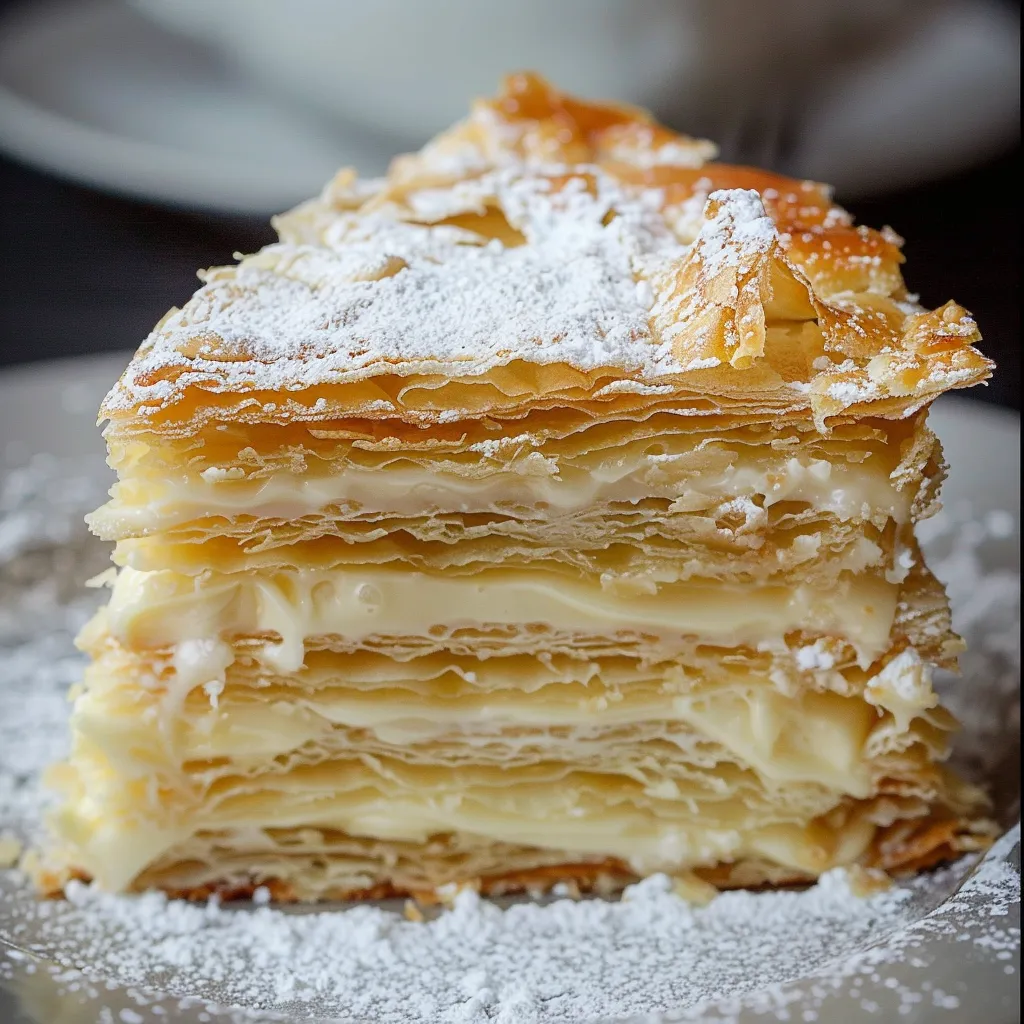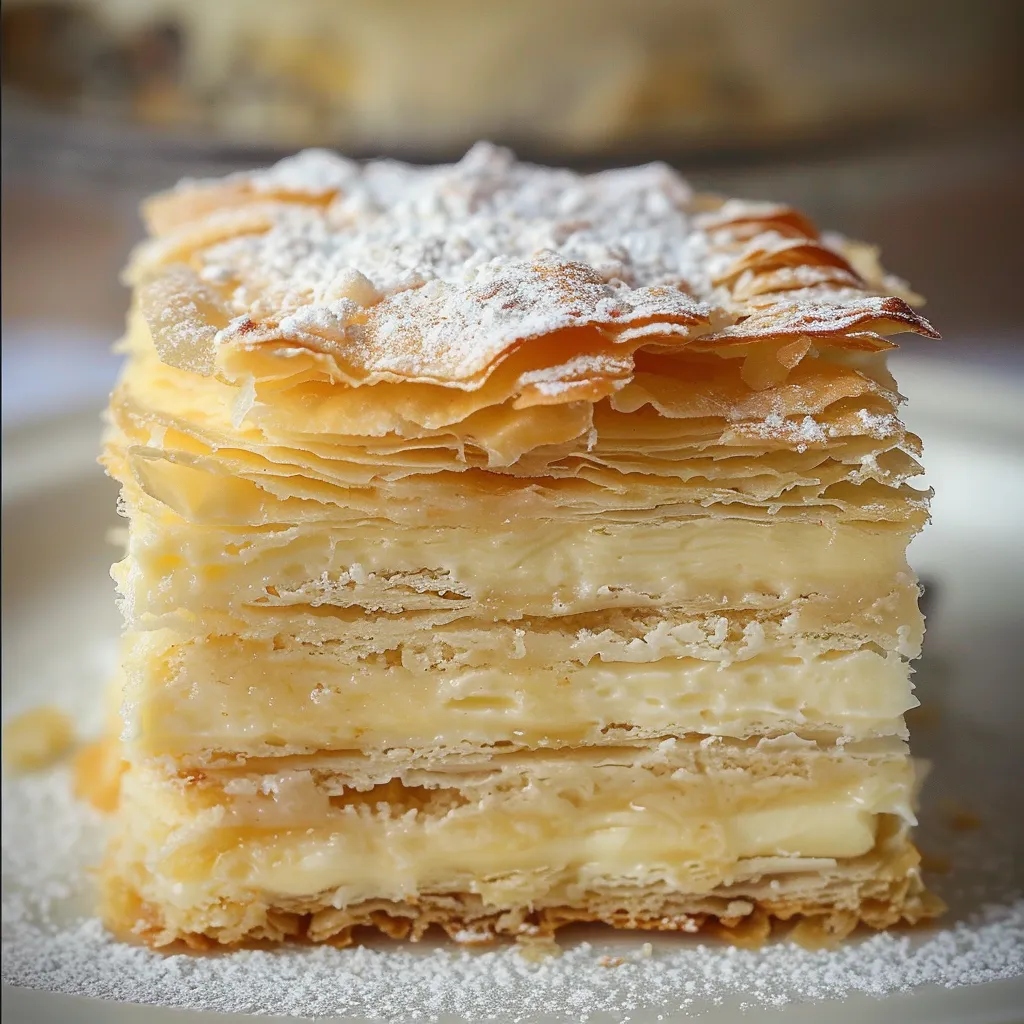 Pin it
Pin it
This flaky layered Russian Napoléon cake is my favorite thing for any big celebration. It always wows my friends and tastes like the real deal every time.
My grandma made this cake for every family get-together. I tinkered with the method until I nailed it, and now it brings back all those warm childhood memories.
Ingredients List
- For speedy puff pastry dough
- Cold unsalted butter: Gives you all those buttery flaky layers.
- Eggs: Make the dough sturdy and richer.
- Ice water: Keeps the dough chilly so the butter doesn't melt out.
- Sifted flour: Helps keep everything airy and light.
- Vodka or brandy: Adds crumbliness and keeps the dough from getting tough.
- White vinegar: Helps perfect those beautiful layers too.
- Salt: Makes all the flavors pop.
- For egg yolk custard filling
- Egg yolks: Make your cream irresistible and thick.
- Whole milk: Best for flavor and a creamy mix.
- Granulated sugar: Sweetens the filling just right.
- Vanilla extract: Adds that cozy, tasty scent.
- Sifted flour: Thickens things up with no lumps.
- Unsalted butter: Makes the final cream rich and shiny.
Step-by-Step Directions
- Making the quick puff pastry
- Blend wet ingredients: Whisk eggs and salt, then add in water, vinegar, and your choice of booze. Stir until mixed, you want everything even for moist dough.
- Mix butter and flour: Toss cold butter and flour in a food processor. Pulse until it looks crumbly—little pea-sized bits of butter are exactly what you want for those layers.
- Add wet blend: Slowly pour the egg mix into the flour-butter and pulse until you're seeing clumps—don't go all the way. Just barely coming together is perfect.
- Shape the dough: Dump it on your counter, gently push together, but don't knead. You want those bits of butter to stay whole for the flakiest layers.
- Divide and chill: Cut into four even pieces, shape into flat rounds, wrap in plastic, and chill in the fridge at least one to two hours. This helps the dough relax and stay cold.
- Whipping up the custard cream
- Main mix: Start by whisking together egg yolks and sugar, splash in some milk to loosen, then add flour until smooth and lump-free.
- Warm up the milk: Gently heat the rest of the milk, stirring so it doesn't scorch. Gradually pour it into the yolk mix while whisking quickly.
- Thicken up the cream: Set over medium heat, bring it to a simmer, and whisk until it's thick—usually takes 2–3 minutes until no floury taste is left.
- Flavor boost: Stir in vanilla and butter. Keep mixing until the butter melts in completely.
- Cool it down: Pour the cream onto a rimmed tray, press plastic wrap right on top to stop a skin from forming, and let it chill out fully.
- Baking the pastry layers
- Get ready: Heat your oven to 200°C and set a baking tray upside down on a damp towel.
- Roll it out: Take one dough piece at a time, split it in half, and roll each into a super thin 32 cm circle right on the tray.
- Bake it off: Prick dough with a fork to keep it from puffing up. Bake 5–7 minutes till light brown. Keep a close eye so they don't burn.
- Trim the rounds: Right out of the oven, use a 28 cm template to cut out perfect circles. Save the scraps for topping later.
- Repeat and crumble: Do this for the rest so you have eight rounds. Crumble all those trims for sprinkling at the end.
- Putting it all together
- Split up the cream: Divide the cooled custard into eight even piles so each layer gets the same amount.
- Start stacking: Smear a little cream on your serving plate. Lay down the first pastry and place a baking ring around it to keep it neat.
- Layer it up: Spread cream over the first round, top with another pastry, keep going till all are stacked and you finish with cream on top.
- Add the topping: Sprinkle crushed crumbs over the top and carefully remove the ring, sliding a knife around the edge first.
- Finish sides: Cover the cake's edges with more cream, press on the leftover crumbs, and gently tap off any loose bits.
Don't skip the vodka in the dough—it's my Russian grandma's secret trick. It keeps the dough extra crumbly by stopping too much gluten from forming. The first time I tried the cake after letting it sit overnight so all the layers melded... that's when I realized why this dessert is so beloved back in Russia.
 Pin it
Pin it
Storing and Serving
Keep your Napoléon cake in the fridge and it'll stay fresh for up to five days. Just loosely cover with foil so you don't mess up the top. As days go by, the cream soaks in and the cake gets softer and tastier.
Swaps and Variations
If you need to skip the alcohol, swap in the same amount of cold water. You can also jazz up the custard with a little lemon or orange zest, or toss in some cinnamon for a different vibe. Want something lighter? Try 2% milk instead of whole, but be aware it'll be less rich.
History Notes
Legend has it, the Russian Napoléon cake came about after Napoleon lost in 1812 when local bakers made it shaped like his hat to celebrate. Over time, it became everyone’s go-to party cake in Russia, with every family putting their spin on it. Unlike the French mille-feuille, which uses classic pastry dough, this one usually takes the super quick version.
Serving Ideas
For extra flair, top the cake with some fresh berries and a dusting of powdered sugar. Serve it up alongside strong black tea like the Russians do. For something festive, try a dollop of lightly sweetened whipped cream or a scoop of vanilla ice cream on the side.
Frequently Asked Questions
- → How can I quickly prep puff pastry for the cake?
Combine sifted flour with chilled butter chunks until crumbly. Add a mix of eggs, ice water, vinegar, and vodka, then bring the dough together without overmixing. Let it chill before layering.
- → Can I skip the alcohol in the dough?
Absolutely, swap the vodka or cognac with cold water to get similar results without alcohol.
- → How can I avoid lumps in the custard?
Keep whisking it constantly as it cooks. If lumps form, strain it through a sieve for a velvety finish.
- → What’s the best way to serve this dessert?
For a softer bite, bring the cake to room temperature after taking it out of the fridge. This helps the custard infuse into the layers.
- → How should I store it?
Refrigerate it covered for up to three days. You can also keep the pastry and custard separate, then assemble when ready to enjoy.
